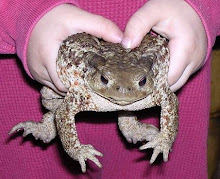Green Anole
2012 Moku Hanga woodcut print
5" x 7"
printed from 6 blocks
We used to wrongly call these lizards, "Florida Chameleons" because the green ones can also turn completely brown--a feature they use for camouflage among the green leaves and brown branches. They are not true chameleons but anoles and are distinguished by their colored dewlap, the extendable flap of skin under the chin. This is the only anole native to Florida although they have been pushed aside by the invasive and more aggressive brown and cuban anoles too. In the suburbs of Miami where I grew up this was NATURE and the closest we could get in our backyards to the wild we'd read about in the nature magazines that would come in the mail.
Many hours were spent trying to catch them and if you handled them too roughly they could bite--a small and harmless but painful pinch. They could also shed their tails and the shortened lizard would scurry away leaving the long green tail, red meaty stub and all, writhing away on the ground like a small snake. The dewlap can be bright red or orange or white, depending on the subspecies.
The male will post himself in some visible location and bob up and down with the brightly colored flap of skin under his neck fanning out to catch the attention to warn away other males or hopefully catch the eye of some svelte green female.
I always liked the habits of this shy small lizard caught between the conflicting urges to be discreet and invisible yet driven to set himself up on some sunlit prominent twig and puff up declaring to all, "HEY, look at ME, Look at ME!"
This was my contribution to the Baren 2012 YEAR of the Dragon print exchange.
It was fun to cut and print and was one of the few prints I've done that printed well on both Japanese and European papers. This one is on Magniani incisioni, an Italian medium-weight etching paper.
Monday, May 7, 2012
Want to see my dewlap?
Labels:
anole,
dewlap,
green,
green anole,
lizard,
moku hanga,
reptile,
woodblock print,
year of the dragon
Subscribe to:
Post Comments (Atom)



A bit redundant to post this again but the colors are a bit different--he's a bit more yellow-green and I wanted to post a decent copy on European paper as many printers are looking for passable and cheaper alternatives to Japanese Washi. Mostly, I wanted to add the small explanation that went out with the print.
ReplyDeleteIt came out great, Andrew. The scaly skin is beautiful, and I really like how it fades into the white underbelly. I like the expression on his face, too.
ReplyDelete